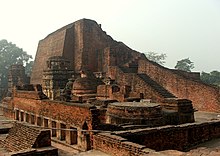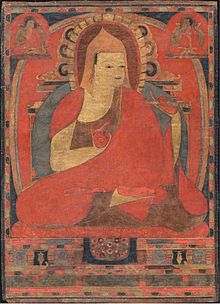User:Gauravkumar4291/Notes/GS/Cul/Pala Empire
Pala Empire[edit]
Introduction[edit]
Pala Empire | |||||||||||
|---|---|---|---|---|---|---|---|---|---|---|---|
| 8th century–12th century | |||||||||||
 The Pala Empire in Asia in 800 CE | |||||||||||
| Capital | List
| ||||||||||
| Common languages | Sanskrit,[3] Proto-Bengali[4] | ||||||||||
| Religion | Mahayana Buddhism, Tantric Buddhism, Shaivism[5] | ||||||||||
| Government | Monarchy | ||||||||||
| Emperor | |||||||||||
• 8th century | Gopala | ||||||||||
• 12th century | Madanapala | ||||||||||
| Historical era | Post-classical | ||||||||||
• Established | 8th century | ||||||||||
• Disestablished | 12th century | ||||||||||
| |||||||||||
| Today part of | Bangladesh India Nepal Pakistan | ||||||||||
- Originated in the region of Bengal.
- They were followers of the Mahayana and Tantric schools of Buddhism.
- The empire was founded with the election of Gopala as the emperor of Gauda in 750 CE.
- The Pala stronghold was located in Bengal and Bihar, which included the major cities of Vikrampura, Pataliputra, Gauda, Monghyr, Somapura, Ramvati (Varendra), Tamralipta and Jaggadala.
- The Palas were astute diplomats and military conquerors.
- Their army was noted for its vast war elephant corps.
- Their navy performed both mercantile and defensive roles in the Bay of Bengal.
- They built grand temples and monasteries, including the Somapura Mahavihara,
- Patronised the great universities of Nalanda and Vikramashila.
- The Proto-Bengali language developed under Pala rule.
- At its height in the early 9th century, the Pala Empire was the dominant power in the northern Indian subcontinent, with its territory stretching across the Gangetic plain to include parts of modern-day eastern Pakistan, northern and northeastern India, Nepal and Bangladesh.
- The empire reached its peak under Emperors Dharmapala and Devapala.
- Pala control of North India was ultimately ephemeral, as they struggled with the Gurjara-Pratiharas and the Rashtrakutas for the control of Kannauj and were defeated.
- Emperor Ramapala was the last strong Pala ruler, who gained control of Kamarupa and Kalinga.
- The empire was considerably weakened by the 11th century, with many areas engulfed in rebellion.
- The resurgent Hindu Sena dynasty dethroned the Pala Empire in the 12th century, ending the reign of the last major Buddhist imperial power in the Indian subcontinent.
- They laid the basis for the Bengali language, including its first literary work, the Charyapada.
- The Pala legacy is still reflected in Tibetan Buddhism.
Geography[edit]

- The borders of the Pala Empire kept fluctuating throughout its existence. Though the Palas conquered a vast region in North India at one time, they could not retain it for long due to constant hostility from the Gurjara-Pratiharas, the Rashtrakutas and other less powerful kings.
- No records are available about the exact boundaries of original kingdom established by Gopala, but it might have included almost all of the Bengal region.
Administration[edit]
The Pala rule was monarchial. The king was the centre of all power. Pala kings would adopt imperial titles like Parameshwara, Paramvattaraka, Maharajadhiraja. Pala kings appointed Prime Ministers. The Line of Garga served as the Prime Ministers of the Palas for 100 years.
- Garga
- Darvapani (or Darbhapani)
- Someshwar
- Kedarmisra
- Bhatta Guravmisra
Pala Empire was divided into separate Bhuktis (Provinces). Bhuktis were divided into Vishayas (Divisions) and Mandalas (Districts). Smaller units were Khandala, Bhaga, Avritti, Chaturaka, and Pattaka. Administration covered widespread area from the grass root level to the imperial court.[6]
The Pala copperplates mention following administrative posts:[7]
- Raja
- Rajanyaka
- Ranaka (possibly subordinate chiefs)
- Samanta and Mahasamanta (Vassal kings)
- Mahasandhi-vigrahika (Foreign minister)
- Duta (Head Ambassador)
- Rajasthaniya (Deputy)
- Aggaraksa (Chief guard)
- Sasthadhikrta (Tax collector)
- Chauroddharanika (Police tax)
- Shaulkaka (Trade tax)
- Dashaparadhika (Collector of penalties)
- Tarika (Toll collector for river crossings)
- Mahaksapatalika (Accountant)
- Jyesthakayastha (Dealing documents)
- Ksetrapa (Head of land use division) and Pramatr (Head of land measurements)
- Mahadandanayaka or Dharmadhikara (Chief justice)
- Mahapratihara
- Dandika
- Dandapashika
- Dandashakti (Police forces)
- Khola (Secret service).
- Agricultural posts like Gavadhakshya (Head of dairy farms)
- Chhagadhyakshya (Head of goat farms)
- Meshadyakshya (Head of sheep farms)
- Mahishadyakshya (Head of Buffalo farms) and many other like Vogpati
- Vishayapati
- Shashtadhikruta
- Dauhshashadhanika
- Nakadhyakshya
Culture[edit]
Religion[edit]


- The Palas were patrons of Mahayana Buddhism.
- Gopala had built the famous monastery at Odantapuri.
- Dharmapala made the Buddhist philosopher Haribhadra his spiritual preceptor. He established the Vikramashila monastery and the Somapura Mahavihara.
- Devapala restored and enlarged the structures at Somapura Mahavihara, which also features several themes from the epics Ramayana and Mahabharata.
- Mahipala I also ordered construction and repairs of several sacred structures at Saranath, Nalanda and Bodh Gaya.
- The Mahipala geet ("songs of Mahipala"), a set of folk songs about him, are still popular in the rural areas of Bengal.
- The Palas developed the Buddhist centres of learnings, such as the Vikramashila and the Nalanda universities.
- Nalanda, considered one of the first great universities in recorded history, reached its height under the patronage of the Palas.
- Noted Buddhist scholars from the Pala period include Atisha, Santaraksita, Saraha, Tilopa, Bimalamitra, Dansheel, Dansree, Jinamitra, Jnanasrimitra, Manjughosh, Muktimitra, Padmanava, Sambhogabajra, Shantarakshit, Silabhadra, Sugatasree and Virachan.
- As the rulers of Gautama Buddha's land, the Palas acquired great reputation in the Buddhist world.
- Balaputradeva, the Sailendra king of Java, sent an ambassador to him, asking for a grant of five villages for the construction of a monastery at Nalanda.
- The Buddhist poet Vajradatta (the author of Lokesvarashataka), was in the court of Devpala.
- The Palas also supported the Saiva ascetics, typically the ones associated with the Golagi-Math.
- Narayana Pala himself established a temple of Shiva, and was present at the place of sacrifice by his Brahmin minister.
- Besides the images of the Buddhist deities, the images of Vishnu, Siva and Sarasvati were also constructed during the Pala dynasty rule.
Literature[edit]
- The Palas patronised several Sanskrit scholars, some of whom were their officials.
- The Gauda riti style of composition was developed during the Pala rule.
- Many Buddhist Tantric works were authored and translated during the Pala rule.
- Besides the Buddhist scholars mentioned in the Religion section above, Jimutavahana, Sandhyakar Nandi, Madhava-kara, Suresvara and Chakrapani Datta are some of the other notable scholars from the Pala period.
The notable Pala texts on philosophy include
- Agama Shastra by Gaudapada,
- Nyaya Kundali by Sridhar Bhatta
- Karmanushthan Paddhati by Bhatta Bhavadeva.
- The texts on medicine include
- Chikitsa Samgraha, Ayurveda Dipika, Bhanumati, Shabda Chandrika and Dravya Gunasangraha by Chakrapani Datta
- Shabda-Pradipa, Vrikkhayurveda and Lohpaddhati by Sureshwara
- Chikitsa Sarsamgraha by Vangasena
- Sushrata by Gadadhara Vaidya
- Dayabhaga, Vyavohara Matrika and Kalaviveka by Jimutavahana
- Sandhyakar Nandi's semi-fictional epic Ramacharitam (12th century) is an important source of Pala history.
- A form of the proto-Bengali language can be seen in the Charyapadas composed during the Pala rule.[8]
Art and architecture[edit]
- The Pala school of sculptural art is recognised as a distinct phase of the Indian art, and is noted for the artistic genius of the Bengal sculptors.[9] It is influenced by the Gupta art.[10]
- Much larger numbers of smaller bronze groups of similar composition have survived than from previous periods. Probably the numbers produced were increasing. These were mostly made for domestic shrines of the well-off, and from monasteries. Gradually, Hindu figures come to outnumber Buddhist ones, reflecting the terminal decline of Indian Buddhism, even in east India, its last stronghold.[11]
-
Carved shankhas
-
Sculpture of Khasarpana Lokesvara from Nalanda
- As noted earlier, the Palas built a number of monasteries and other sacred structures.
- The Somapura Mahavihara in present-day Bangladesh is a World Heritage Site. It is a monastery with 21 acre (85,000 m²) complex has 177 cells, numerous stupas, temples and a number of other ancillary buildings.
- The gigantic structures of other Viharas, including Vikramashila, Odantapuri, and Jagaddala are the other masterpieces of the Palas. These mammoth structures were mistaken by the forces of Bakhtiyar Khalji as fortified castles and were demolished.
- The art of Bihar and Bengal during the Pala and Sena dynasties influenced the art of Nepal, Burma, Sri Lanka and Java.
-
Somapura Mahavihara, a World Heritage Site, was built by Dharmapala
-
Central shrine decor at Somapura
-
Ruins of Vikramashila
Military[edit]
- The highest military officer in the Pala empire was the Mahasenapati (commander-in-chief).
- The Palas recruited mercenary soldiers from a number of kingdoms, including Malava, Khasa, Huna, Kulika, Kanrata, Lata, Odra and Manahali.
- According to the contemporary accounts, the Rashtrakutas had the best infantry, the Gurjara-Pratiharas had the finest cavalry and the Palas had the largest elephant force.
- The Arab merchant Sulaiman states that the Palas had an army bigger than those of the Balhara (possibly the Rashtrakutas) and the king of Jurz (possibly the Gurjara-Pratiharas). He also states that the Pala army employed 10,000–15,000 men for fuelling and washing clothes. He further claims that during the battles, the Pala king would lead 50,000 war elephants. Sulaiman's accounts seem to be based on exaggerated reports;
- Ibn Khaldun mentions the number of elephants as 5,000.
- Since Bengal did not have a good native breed of horses, the Palas imported their cavalry horses from the foreigners, including the Kambojas.
- They also had a navy, used for both mercantile and defence purposes.
See also[edit]
Wikimedia Commons has media related to Gauravkumar4291/Notes/GS/Cul/Pala Empire.
- Middle kingdoms of India
- Nalanda
- Vikramashila
- Somapura Mahavihara
- Jagaddala Mahavihara
- Odantapuri
- Kurkihar hoard
Sources[edit]
The main sources of information about the Pala empire include:[12]
- Pala accounts
- Various epigraphs, coins, sculptures and architecture
- Ramacharita, a Sanskrit work by Abhinanda (9th century)
- Ramacharitam, a Sanskrit epic by Sandhyakar Nandi (12th century)
- Subhasita Ratnakosa, a Sanskrit compilation by Vidyakara (towards the end of the Pala rule)
- Other accounts
- Silsiltut-Tauarikh by the Arab merchant Suleiman (951 CE), who referred to the Pala kingdom as Ruhmi or Rahma
- Dpal dus khyi 'khor lo'i chos bskor gyi byung khungs nyer mkh (History of Buddhism in India) by Taranatha (1608), contains a few traditional legends and hearsays about the Pala rule
- Ain-i-Akbari by Abu'l-Fazl (16th-century)
This page will be placed in the following categories if it is moved to the article namespace.
Categories: - ^ Michael C. Howard (2012). Transnationalism in Ancient and Medieval Societies: The Role of Cross-Border Trade and Travel. McFarland. p. 72. ISBN 978-0-7864-9033-2.
- ^ Huntington 1984, p. 56.
- ^ Sengupta 2011, p. 102.
- ^ Bajpai, Lopamudra Maitra (2020). India, Sri Lanka and the SAARC Region: History, Popular Culture and Heritage. Abingdon: Taylor & Francis. p. 141. ISBN 978-1-00-020581-7.
- ^ The Śaiva Age: The Rise and Dominance of Śaivism during the Early Medieval Period. In: Genesis and Development of Tantrism, edited by Shingo Einoo. Tokyo: Institute of Oriental Culture, University of Tokyo, 2009. Institute of Oriental Culture Special Series, 23, pp. 41–350.
- ^ Paul 1939, p. 122–124.
- ^ Paul 1939, p. 111–122.
- ^ Sailendra Nath Sen (1999). Ancient Indian History and Civilization. New Age International. pp. 277–287. ISBN 978-81-224-1198-0.
- ^ Chowdhury, AM (2012). "Pala Dynasty". In Islam, Sirajul; Jamal, Ahmed A. (eds.). Banglapedia: National Encyclopedia of Bangladesh (Second ed.). Asiatic Society of Bangladesh.
- ^ Rustam Jehangir Mehta (1981). Masterpieces of Indian bronzes and metal sculpture. Taraporevala. p. 21. ISBN 9780865900479.
- ^ Harle, 212; Craven, 176
- ^ Bagchi 1993, pp. 2–3.








